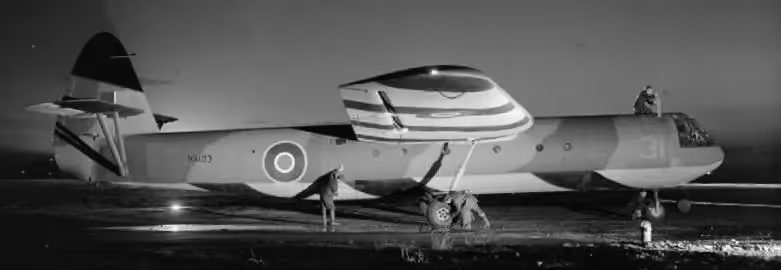Canadian Warplanes 9: Airspeed Horsa Gliders
Airspeed Gliders

(RAF Photo)
Airspeed Horsa Transport Glider, RAF (Serial No. DP726).
The Airspeed AS.51 Horsa was a British troop-carrying glider used during the Second World War. It was developed and manufactured by Airspeed Limited, alongside various subcontractors; the type was named after Horsa, the legendary 5th-century conqueror of southern Britain.
Having been greatly impressed by the effective use of airborne operations by Nazi Germany during the early stages of the Second World War, such as during the Battle of France, the Allied powers sought to establish capable counterpart forces of their own. The British War Office, determining that the role of gliders would be an essential component of such airborne forces, proceeded to examine available options. An evaluation of the General Aircraft Hotspur found it to lack the necessary size, thus Specification X.26/40 was issued. It was from this specification that Airspeed Limited designed the Horsa, a large glider capable of accommodating up to 30 fully equipped troops, which was designated as the AS 51.
The Horsa was used in large numbers by the British Army Air Corps and the Royal Air Force (RAF); both services used it to conduct various air assault operations through the conflict. The type was used to perform an unsuccessful attack on the German Heavy Water Plant at Rjukan in Norway, known as Operation Freshman, and during the invasion of Sicily, known as Operation Husky. Large numbers of Horsa were subsequently used during the opening stages of the Battle of Normandy, being used in the British Operation Tonga and American operations. It was also deployed in quantity during Operation Dragoon, Operation Market Garden, and Operation Varsity. Further use of the Horsa was made by various other armed forces, including the United States Army Air Forces. (Wikipedia)
Flight Sergeant Douglas Harrison Stewart, RCAF, and one RAF airman were killed in a flying accident (KIFA) when a Horsa glider crashed at RAF Station, Wroughton in the UK on 15 Oct 1942. He was serving with serving with No. 15 Maintenance Unit.
Airspeed AS 51 Horsa Mk. I & II Transport Glider (3), (Serial Nos. TL334, TL349, TL401).

(RAF Photo)
Airspeed Horsa Transport Gliders.

(IWM Photo, CH 10356)
Airspeed Horsa Mk. I (Serial No. DP383), coded 46, of the Heavy Glider Conversion Unit, on the ground at Brize Norton, Oxfordshire in the UK.

(IWM Photo, CH 7787)
An Airspeed Horsa Mark I troop-carrying glider is hooked up to an Armstrong Whitworth Whitley Mark V glider-tug of No. 297 Squadron RAF, before taking off, during an organised press visit to No. 38 Wing RAF and the Airborne Division at Netheravon, Wiltshire.

(IWM Photo, CH 10228)
Airspeed Horsa Mk. I (Serial No. HS103), coded 31, of the Heavy Glider Conversion Unit in the UK, being inspected before commencing night flying at Brize Norton, Oxfordshire.

(IWM Photo, H 39183)
An Airspeed Horsa glider carrying troops of 6th Airlanding Brigade is towed aloft by an Armstrong Whitworth Albemarle at an RAF airfield, part of 6th Airborne Division's second lift in the evening of 6 June 1944.

(IWM Photo, HU 92976)
Oblique photographic-reconnaissance vertical, taken from 800 feet, showing part of Landing Zone 'N', north of Ranville, Normandy, on the day following Operation Mallard, the airborne landing of the 6th Airlanding Brigade and the Airborne Armoured Reconnaissance Regiment in the evening of 6 June 1944. Airspeed Horsa troop-carrying gliders and one damaged GAL Hamilcar tank-carrying glider (lower right) litter this part of the LZ close to the Ranville-Salanelles road.

(RAF Photo)
Airspeed Horsa Transport Gliders, Operation Market Garden, 1944.


(Happy Days Photos)
Airspeed Horsa Mk. II glider (Serial No. KJ351), Museum of Army Flying, Middle Wallop, Hampshire. The museum holds the substantial remains of three Airspeed Horsa Mk. IIs.

(RAF Photo)
Airspeed Horsa.





